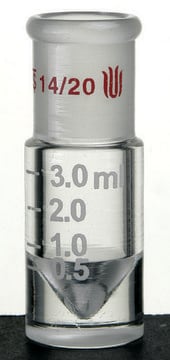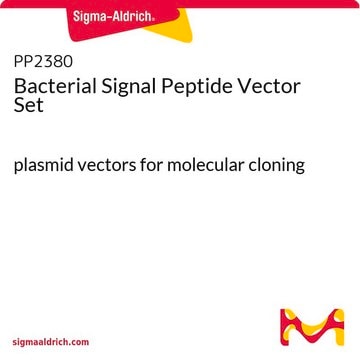PP2357
Yeast Promoter Vector Set
plasmid vectors for molecular cloning
Sinónimos:
cloning vector, expression vector, molecular cloning vector, plasmid, plasmid vector, vector
About This Item
Productos recomendados
form
buffered aqueous solution
bacteria selection
kanamycin
origin of replication
2Micron
pUC (500 copies)
promoter
Promoter name: TEF1
Promoter activity: constitutive
Promoter type: yeast
shipped in
ambient
storage temp.
−20°C
General description
Use this plasmid pack to compare five different yeast promoters, each driving expression of your chosen gene inserted into the MCS. The pack includes strong, medium and weak constitutive promoters, and one inducible promoter. Each plasmid contains the URA3 selection gene. This should allow you easily to determine which promoter gives the desired level of expression of your gene of interest and to select for transformed yeast cells.This plasmid set has been designed to be compatible with a range of cloning techniques. The multiple cloning site contains a range of standard commonly used restriction sites for cloning. Using these sites genes can be inserted using standard cloning methods with DNA ligase. Other methods such as ligase independent cloning (LIC) Gibson Assembly InFusionHD or Seamless GeneArt can also be used and because all of our plasmids are based on the same backbone the same method can be used for cloning into all of our catalogue vectors.
Multiple cloning site notes: There are a few important sites within the MCS. These include the NcoI site the XbaI site and the BsgI and BseRI sites. The NcoI site contains a start codon that is immediately downstream of both a Kozak and Shine-Dalgarno ribosomal binding site. These allow for optimal positioning of genes when the start codon is placed in this location. If this is not required and you wish to use a downstream site for gene cloning you can remove the NcoI site by cleaving the plasmid with KpnI. The XbaI site contains a stop codon. This stop codon is positioned in a specific position in relation to the BsgI and BseRI sites that are immediately downstream. When either BseRI or BsgI cleave the plasmid they produce a TA overhang from the stop codon in the XbaI site that is compatible with all of our peptide tag plasmids cut with the same sites. BseRI and BsgI sites are non-palindromic and cleave a defined number of bases away from their binding site. Whenever we clone a gene into our multiple cloning site we always position the start and stop codon in the same positions in the MCS. If the start and ends of the genes are not compatible with NcoI and XbaI we extend the sequence to the nearest external sites but keep the start and stop codons locations consistent.
Transcription Termination:<p>These plasmids contains three alternative transcription terminators for mammalian bacterial and bacteriophage (T7) expression. This means that only the promoter needs to be changed to alter the expression system you are using. We sell multiple promoters that can be used in each of these systems. The presence of each terminator does not reduce expression in the alternative systems.
Intellectual Property Status: According to our IP-friendly policy this plasmid is sold free of reach-through rights and can be used to make commercial products. However the plasmid itself (or derivatives) cannot be sold.
Sequence
Analysis Note
Legal Information
Los componentes del kit también están disponibles por separado
- OGS534PSF-TEFI-URA3 - URACIL YEAST SELECTION PLASMID, plasmid vector for molecular cloningSDS
- OGS535PSF-STE5-URA3 - WEAK PROMOTER YEAST PLASMID, plasmid vector for molecular cloningSDS
- OGS536PSF-GAL1-URA3 - GALACTOSE INDUCIBLE YEAST PLASMID, plasmid vector for molecular cloningSDS
- OGS537PSF-ADH1-URA3 - MEDIUM STRENGTH YEAST PROMOTER PLASMID, plasmid vector for molecular cloningSDS
- OGS538PSF-TPI1-URA3 - STRONG PROMOTER YEAST PLASMID, plasmid vector for molecular cloningSDS
Related product
Storage Class
12 - Non Combustible Liquids
flash_point_f
Not applicable
flash_point_c
Not applicable
Certificados de análisis (COA)
Busque Certificados de análisis (COA) introduciendo el número de lote del producto. Los números de lote se encuentran en la etiqueta del producto después de las palabras «Lot» o «Batch»
¿Ya tiene este producto?
Encuentre la documentación para los productos que ha comprado recientemente en la Biblioteca de documentos.
Nuestro equipo de científicos tiene experiencia en todas las áreas de investigación: Ciencias de la vida, Ciencia de los materiales, Síntesis química, Cromatografía, Analítica y muchas otras.
Póngase en contacto con el Servicio técnico








